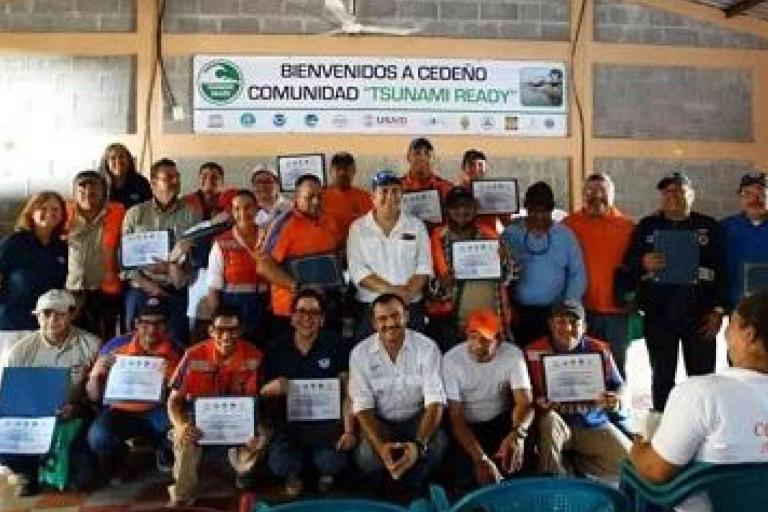Technology and communities key to curbing tsunami risk

PARIS, 24 February 2017 – Deploying the power of technology worldwide and ensuring that communities know how to act in an emergency are the keys to curbing the risks posed by tsunamis, experts said this week.
Senior officials from the world’s regional tsunami alert centres have spent the past four days taking stock of progress in the development and implementation of warning and mitigation systems.
They are crafting recommendations for a full session in June of the UN Educational, Scientific and Cultural Organization’s Intergovernmental Oceanographic Commission (IOC-UNESCO), which is hosting this week’s meeting at its Paris base.
Among the key themes is how to make sure the latest alert technology – for example, real-time satellite monitoring – provides coverage in all risk zones.
“It is important that the world moves forward, but we have to ensure that all countries can do so, that everyone can benefit from all the technology and data that exists,” said Dr. Vladimir Ryabinin, IOC-UNESCO Executive Secretary.
He underlined that the critical role of science and technology was made clear in the Sendai Framework for Disaster Risk Reduction. The 15-year blueprint was adopted by the international community in 2015 and was the first building block of the global sustainable development agenda.
The Sendai Framework’s seven targets include substantially reducing lives lost, numbers of people affected, and economic damage from natural and human-induced hazards. The mortality reduction target was the theme of the debut edition of the annual World Tsunami Awareness Day on 5 November 2016.
Early warning and full community engagement are identified as critical areas in the Sendai Framework, whatever the hazard. Both are particularly important when it comes to tsunami risk, and will also be key issues at the 2017 Global Platform for Disaster Risk Reduction in May in Mexico.
Mostly caused by earthquakes under the ocean floor, tsunamis are relatively rare. But they can be deadly: in the past 100 years, 58 have cost more than 260,000 lives. The average toll, 4,600 per disaster, surpasses any other natural hazard.
The deadliest was the 2004 Indian Ocean tsunami. It killed an estimated 227,000 people in 14 countries. Indonesia, Sri Lanka, India and Thailand were hardest-hit. With 9,000 tourists from dozens of other nations among the victims, the disaster also had the worst global impact by a natural hazard in recorded history.
In the tragedy’s wake, the international community set up regional tsunami warning systems overseen by IOC-UNESCO. Their example was the Pacific Tsunami Warning Center, founded by the United States in 1949 after an earthquake and tsunami in Alaska and Hawaii, which became the hub of a regional system in 1965.
Experts say it’s essential to make sure that all countries within a regional alert system – and everyone down the chain within a country – have a clear and common understanding of the terminology used.
“In the heat of battle, with a tsunami rapidly approaching, we don’t want people going, ‘What’s that bulletin, what does that data mean?’,” said Dr. Rick Bailey, Head of Tsunami Warning and Ocean Services at the Australian Bureau of Meteorology, representing the Indian Ocean Tsunami Warning and Mitigation System.
The Indian Ocean system, operational since 2005, taps data from scores of seismographic and sea-level monitoring stations, with threat information supplied by Australia, India and Indonesia.
Its 24 member countries, like those in the other alert systems, hold regular drills, and have worked to bridge the “last mile” from the experts to the general public.
Twelve countries held community evacuations during the IOWAVE16 drill last September, up from just two during the previous edition in 2014. Over 58,000 people took part, mostly in India.
“These exercises are great if they get countries really thinking, ‘How should we respond?’ Getting people together and showing what works and what doesn’t is vital,” said Dr. Bailey.
Ms. Christa von Hillebrandt-Andrade, Manager of the United States’ National Oceanic and Atmospheric Administration’s Caribbean Tsunami Warning Program, underlined the need to put communities at the heart of operations. It’s an approach adopted in her region’s alert network, which covers 48 countries and territories.
“Instead of having the community at the end of a long chain of communications, we have the community at the centre of the warning system,” she explained. That involves increasing community awareness of tell-tale tsunami signs such as significant sea-level changes and strong ground shaking, as well as having the capabilities to receive official warnings.
“We need communities to have a culture of evacuation,” she added. Successes include the fact that 332,000 people took part in the CARIBE WAVE 2016 tsunami drill.
To sharpen the preparedness focus, the Caribbean is piloting the IOC-UNESCO voluntary, performance-based Tsunami Ready community recognition programme, based on the original US version. To achieve recognition, communities need to have taken specific actions such as having tsunami risk and evacuation maps, installation of public signage, conduct of annual community drills and round-the-clock local alerting capabilities.
The twin-island nation of Saint Kitts and Nevis, which has a population of some 57,000, and Cedeño, a fishing community of around 4,000 in Honduras, were both recently recognised by IOC-UNESCO as Tsunami Ready.
There are now plans to pilot the Tsunami Ready programme in other regions of the globe.
- WMO Member:
- Honduras

